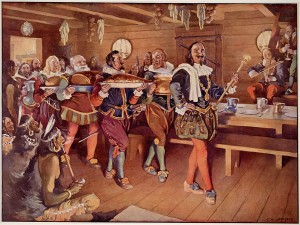By Elizabeth C. Goldsmith (Regular Contributor)
 When the explorer Samuel de Champlain built a fortified settlement on the south shore of the Bay of Fundy in 1606, he and the group of men who accompanied him were determined to survive the winter in good health. Many of their number – more than thirty – had died of scurvy in the previous year. Europeans at the time didn’t know precisely what foods could prevent scurvy, but they did believe that better nutrition would be key to healthy survival in their new settlement of Port-Royal. Medical treatises also advised that scurvy could be combatted by avoiding the boredom and depression that so often accompanied winter in northern climes. So along with some regular feasting they needed to plan good entertainment.
When the explorer Samuel de Champlain built a fortified settlement on the south shore of the Bay of Fundy in 1606, he and the group of men who accompanied him were determined to survive the winter in good health. Many of their number – more than thirty – had died of scurvy in the previous year. Europeans at the time didn’t know precisely what foods could prevent scurvy, but they did believe that better nutrition would be key to healthy survival in their new settlement of Port-Royal. Medical treatises also advised that scurvy could be combatted by avoiding the boredom and depression that so often accompanied winter in northern climes. So along with some regular feasting they needed to plan good entertainment.
L’Ordre du Bon Temps
 They dubbed their new organization ‘The Order of Good Cheer’. This social club pledged to provide festive meals at least every couple of weeks throughout the winter season. The primary beneficiaries were the noblemen and other prominent French settlers, with members of the Mi’kmaq Nation who had assisted in constructing the Port Royal stockade also attending and receiving leftovers. One of the Frenchmen in regular attendance was the writer and poet Marc Lescarbot. He provided theatrical pieces that were staged to music to entertain the guests. The dinners were hosted by Monsieur de Poutrincourt, the appointed leader of the settlement, and the food was provided by all members of the club, who took turns bringing in meat from the hunt and vegetables that had been preserved from summer gardens.
They dubbed their new organization ‘The Order of Good Cheer’. This social club pledged to provide festive meals at least every couple of weeks throughout the winter season. The primary beneficiaries were the noblemen and other prominent French settlers, with members of the Mi’kmaq Nation who had assisted in constructing the Port Royal stockade also attending and receiving leftovers. One of the Frenchmen in regular attendance was the writer and poet Marc Lescarbot. He provided theatrical pieces that were staged to music to entertain the guests. The dinners were hosted by Monsieur de Poutrincourt, the appointed leader of the settlement, and the food was provided by all members of the club, who took turns bringing in meat from the hunt and vegetables that had been preserved from summer gardens.
The Essential Ingredient
At the end of the winter, only seven settlers had succumbed to scurvy, and these were poor folk who had not been present at many of the feasts. Champlain and Poutrincourt congratulated themselves on the success of ‘The Order of Good Cheer’. But modern historians have been mystified, because the key ingredient for preventing scurvy – vitamin C – was not present in the generous portions of meats and vegetables that the settlers managed to keep on the table that winter.

Recently, a closer look at the menus as described in Port-Royal reports and letters sent back to France has yielded a clue. The settlers describe eating a new food that they call “small red apples.” These were no doubt cranberries, rich in vitamin C. This was an item on the menu that had probably been introduced to the settlers by their Mi’kmaq neighbors. They are still called “pommes de prés,” or meadow apples, today in Acadia.
For Further Reading:
Samuel de Champlain, Voyages (1613)
Raymonde Litalien and Denis Vaugeois, eds., Champlain: The Birth of French America (2005)
